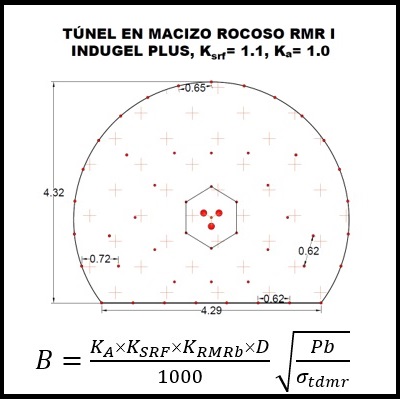RMR and type of explosive: incidence in underground blasting
DOI:
https://doi.org/10.24054/bistua.v19i1.959Keywords:
RMR, Burden, Indugel Plus AP, ANFO, Resistencia a tracción dinámica de la roca intacta y del macizo rocosoAbstract
Bieniawski's rock mass classification, RMR -Rock Mass Classification- is, together with Barton's Q and Hoek's GSI, the three most frequently used classification systems in many countries including Colombia as an aid to determine several rock mass properties, which would otherwise be very tedious and costly to determine. These characteristics allow predicting the self-supporting times of an underground excavation, as well as its type of support, speed of advance and complexity of construction and based on them determine costs and excavation times of these structures as accurately as possible, and although it is recommended to use the drilling and blasting advance method for rock massifs with RMR of I, II and III, in the literature no direct relationship is found between the RMR and the dimensions of the burden, spacing or the stemming. It is also true that most of the expressions proposed to determine these parameters (burden, spacing, and stemming) only consider the density of the rock and the explosive; a few, the velocity of the waves in the medium and others, the compressive or tensile strength. On the other hand, underground excavations are characterized by their confined state due to depth, by the shape and size of the area to be excavated, as well as by geometrical parameters inherent to the drilling process such as diameter, length, direction, and the absence of a free face. These conditions imply that the influence of these parameters should be reflected in the designs of the underground drilling and blasting mesh. The results of the research we have been carrying out allow us to propose an expression that considers the dynamic tensile properties of the rock mass to be in accordance with the dynamic characteristics generated by the explosive, which also enters as an important variable; in addition, we are considering the level of explosive load coupling, the dimensions of the tunnel section, its confinement conditions and the RMR in which it is immersed.
Downloads
References
Correa Á., Rueda J.F., Rodríguez F.B.; En: “Manual para el diseño, construcción, operación y mantenimiento de túneles de carretera para Colombia, INVIAS, Edición (2021), Capítulo 6, 6.7.2 Esquema de voladura, Pagina 220.
López J.C. (1994) “Manual de perforación y voladura de rocas”. Instituto Tecnológico GeoMinero de España
Borquez G.V. (1981), “Estimation of drilling and blasting cost – An analysis and prediction model”, Engineering and Mining Journal, January 1981, pp83-89.
López J.C., (2013) “Manual de perforación en túneles”. E.T.S.I. Minas Universidad Politécnica de Madrid, España.
Diéguez G.Y., et al., “Campo tenso-deformacional para voladuras con cordón detonante en el laboreo de túneles”, Revista Minería y Geología, Vol. 29 No.3 (2013), p. 38-55.
Hoek E., (2000). “Rock Mass Properties”. En Practical Rock Engineering
González de Vallejo, L,I. (2006). “Ingeniería Geológica”, Pearson Educación, Madrid
INDUMIL. (2009). “Guía del Explosivista”
INDUMIL. (2018). “Manual para explosivos Industriales”
López J.C, (2010) “Manual de voladuras en túneles”. E.T.S.I. Minas – Universidad Politécnica de Madrid, España

Additional Files
Published
Versions
- 2021-06-19 (2)
- 2021-06-19 (1)
How to Cite
Issue
Section
License
Copyright (c) 2021 © Autores; Licencia Universidad de Pamplona.

This work is licensed under a Creative Commons Attribution-NonCommercial-NoDerivatives 4.0 International License.
© Autores; Licencia Universidad de Pamplona





